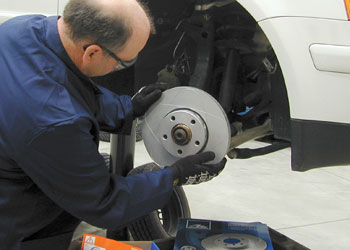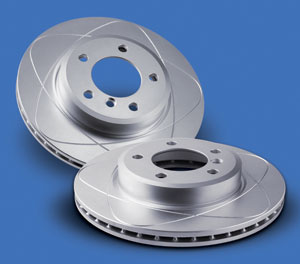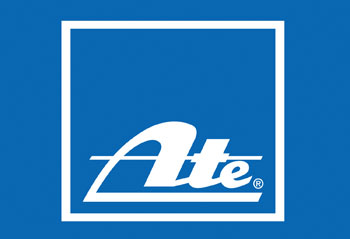 Problem: Cracked pot/hat
Problem: Cracked pot/hat
Visible clues: Disc pot cracked near a wheel bolt.
Possible cause: Bolt(s) improperly press-fitted.
Solution: Press-fit bolts in accordance with manufacturer’s data.
Problem: Judder and noise
Visible clues:
• Overheating marks on outside of friction ring; and
• Pad material deposits and cracks.
Possible causes: Jammed bushings and guide.
Solutions: Replace bushings and guides or complete caliper set, if necessary.
Problem: Judder
Visible clue: Excessive heat marks on friction ring.
Possible causes:
• Overheating due to excessive braking;
• Brake not releasing;
• Pistons jammed or rusted solid in caliper;
• Pads jammed in caliper; and
• Stiff guide.
Solutions: Check calipers for free movement / Inspect pads and bushings / Check for residual pressure in system / Advise customer not to overstrain brakes.
Problem: Judder and shimmy
Visible clue: Heat bluing on both sides of friction ring after very little use.
Possible causes:
• Inadequate bedding-in;
• Overstraining of brakes;
• Residual pressure in system;
• Pistons jammed or rusted solid in caliper;
• Pads jammed in caliper; and
• Stiff guide.
Solutions: Inspect hydraulic system / Advise customer on possible overstraining / Follow proper bedding-in and operating instructions.
Problem: Judder, shimmy and noise
Visible clue: Layer of rust on friction ring is lifting.
Possible causes:
• An extended service life has resulted in a badly rusted disc; and
• Water damage.
 Solutions:
Solutions:
• Check caliper channel and the pads for free movement; and
• Lightly grease caliper and pad contact surfaces.
ATE PremiumOne Disc Brake Rotors are engineered to help reduce brake fade, which can cause drivers to overstrain the brakes. The rotors also reduce overheating and noise via a patented groove that dissipates heat and gases and disperses dirt and water.
For more information, visit: www.ate-na.com or contact: [email protected].
Courtesy of ATE Brake Products.














